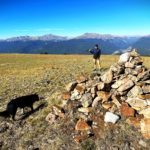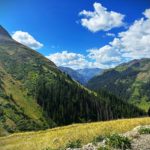This week we were back in Colorado with our pup looking for the perfect campsite and hike. Oddly, we found both. We made our way over the Brazos Mountains on our way out of New Mexico, through Alamosa and up the Rio Grande valley towards the San Juan range in Colorado. After stopping at the USFS station in Salida, CO to pick up a couple of maps we were missing, we headed north towards Leadville with the intention of stopping somewhere near Twin Lakes – a glacier carved lake that has been dredged and appropriated by us humans to provide water storage for the hoards that live hundreds of miles away on Colorado’s front range. We took one look at the scene there and decided that while beautiful, it was not for us. Established campgrounds attract a crowd with tastes different than ours.
Back down the road a bit, I’d spotted a steep, dirt forest service road that turned off in the small burg of Granite. So, we left the lakes and headed back down. Once off the mellow, domesticated highway 24, the road turned very dusty, steep and rugged and a perfect match for the Toyota 4runner and provided a deterrent for the people we left behind at Twin Lakes. The reason for the road, as most in mountainous Colorado was initially mining access. The miners always go straight up as they were an efficient bunch if nothing else. These days, the miners are gone and the road provides an access point into the Buffalo Peaks Wilderness Area. About 4 miles up the road, my wife yelled at me to stop. And there it was… A side road/loop that was perfectly flat and hidden away from the main road that would provide a perfect overnight spot with spectacular views of the Collegiate Peaks across the valley. Not only that, but it would provide access to a trailhead into the Buffalo Peaks WA and one of the most incredible vistas I’ve seen in Colorado. I exaggerate not when I say that she had found the perfect campsite.
While we were setting up camp, another 4runner came down the road but never saw us. After that, we didn’t see another soul (other than a large heard of elk) until we dropped back down to Granite on our way out. Here you can see our “overlanding” setup fully deployed.
The setup features a Roofnest cartop tent (one of the few that accomodates my long frame) on a Victory rack with a moveable sunshade. Folding table and chairs are placed next to a Partner Steel dual burner stove, Dometic 12v refrigerator and a home built battery unit that can be charged off of vehicle, solar or a land connection and which keeps the fridge going for days. Once parked, the whole thing can be setup and the first beer cracked open in a matter of a few minutes. I can assure you that the dog was more than ready to get out of that truck!
Early morning next, we took off walking up to the trailhead and continued to the top of the ridge that runs N/S through the Buffalo Peaks wilderness. Just as we got to the treeline at about 11,500 feet or so, we walked into a large heard of elk with several magnificent bulls at the back of the pack. We watched them grazing in the cool morning air for a few minutes until they picked up our presence and started moving reluctantly away from us. Once they were out of sight and over the ridge, we proceeded up. Below, you can get some sense of the views from the top. However, this picture does not begin to describe the awe inspiring vistas all around us. In the distance, the Collegiate peaks represent one of the highest concentration of 14,000 ft + peaks anywhere in the lower USA. We were standing between a couple of extinct volcanoes that were formed with a completely different geology from the 14’ers across the valley. The Colorado mountains are a study in geological contrasts. I devoured multiple sections of my expertly and competently written “Roadside Geology of Colorado” book on this trip.
Here we stand between the two volcanic Buffalo Peaks and look across to the granite monoliths across the valley. Born in different ages and of different materials, the two ranges couldn’t be more different. One of the most fascinating features of the San Juan Range is it’s volcanism as it features the most massive extinct volcano on the planet earth. Just south of here lies the La Garrita Caldera which when it exploded was almost 5,000 times the magnitude of the Mt. St. Helens eruption in 1980. If you’ve ever seen St. Helens, the scale of La Garrita is impossible to imagine. In addition, it is only one of about 18 smaller but massive calderas that all conspired to form the San Juan Range.
After leaving this beautiful place, we headed back down the hill and caught state highway 50 that, after topping out at Monarch pass follows the Gunnison River all the way to the west coast of Colorado at Grand Junction. Instead of continuing down the Gunnison, we diverted after the eponymously named town of Gunnison down highway 149 and camped at a place called Powderhorn on our way to Lake City and the Alpine Loop.
The Alpine loop could be considered one of the “holy grail” routes for overlanders like ourselves. It is a super challenging unimproved mountain road (if you can call it that) that climbs up through some of the San Juan range’s highest peaks to 12,600 feet on both Cinnamon and Engineer passes. If the altitude weren’t enough, the giant holes, boulders, curves and steep slopes encountered on the road limit your speed to no more than 5 mph and shake every organ in your body. The 4runner handled all the loop could throw at it and never broke a sweat – though I did. Here we stop just after Cinnamon pass to take in the view.
Before leaving the loop, we stopped in Animas Forks , a ghost town that provides a valuable lesson in just how important mining history is to this part of the world. While mining has contributed to many environmental disasters, including a very recent and horrendous event on on the Animas River, we arguably would not be seeing this country if it weren’t for the tough, hardrock miners that developed the infrastructure to get here. Maybe it would be better if they had left it alone? Something to ponder. After completing the loop, it was south through Silverton and on to lunch with some friends in Durango and home to New Mexico. The overland tour through the San Juans of Colorado was successful and one we won’t soon forget.



